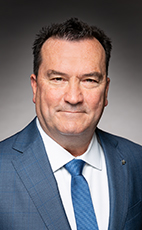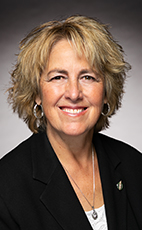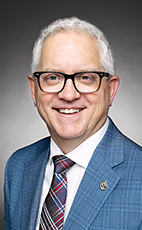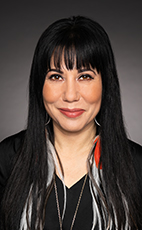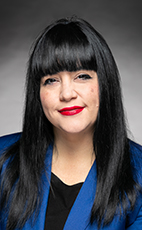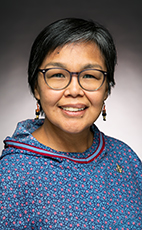44th Parl. 1st Sess.
May 4, 2022 02:00PM
Madam Speaker, I am very pleased to speak on this subject that keeps coming up. Obviously there is interest in it.
It also seems to appeal to young people, even though the member for Winnipeg North said that young people do not want to vote. In reality, 16- and 17-year-olds have gone to the Ontario Superior Court of Justice to seek the right to vote by challenging the constitutionality of the law.
My colleague from Skeena—Bulkley Valley talked about the benefit of having 16- to 18-year-olds vote. If these young people vote, participation in the democratic process is sure to increase as the pool of voters gets bigger. It is simple math, and it does not take a Ph.D. to know that. The question is more whether these young people will actually go out and vote, but I will come back to that a little later.
First, I want to respond to what my colleague from Winnipeg North said. He stated that we need to encourage people to vote and we need to find ways to encourage them. He is looking for ways because he is a dynamic guy, as we know. Everybody in the House knows him.
I can give him some ideas. When I was in Quebec City, sitting as part of the opposition in the National Assembly, we asked questions, and the ministers usually gave us answers. When they did not, we invoked a standing order to remind the ministers that they had to answer.
When I arrived in Ottawa, I was told to brace myself. Ministers in Quebec City do not always answer questions, but the federal government gives nothing but nonsense answers. No matter what question is asked, the government reads from the same talking points, even if the answer is completely unrelated.
If the Liberals really want to help get the vote out, they need to respect the voters' intelligence and answer the questions put to them by the opposition, because those questions are coming from the voters. If the government really wants to increase voter turnout, it needs to start treating the public and voters with respect and answer the questions.
If they respected the public, they would remember that on September 25, 2021, the people elected a minority Liberal government and the NDP was relegated to the opposition. That was what the people wanted, what they decided.
Had the government respected voters' intelligence—had it respected voters, period—it would have respected the fact that this government was supposed to be a minority government and that the NDP was supposed to be an opposition party, but the very people who make a big to-do about boosting voter turnout are the same ones saying that the way people voted does not matter and that they are entering into an alliance for whatever reason and giving a minority government a majority.
Maybe if people felt respected, more of them might vote. Voter turnout has been in free fall for forty-some years, and even though it edged up recently, that is nothing to get excited about. The point is, let us start by respecting voters 18 and up before we start talking about the 16- to 18-year-olds.
Let us look at voting rights for 16- to 18-year-olds. I find this so interesting. There are some main ideas I would like to work on with the member.
First, it has been proven that a voter who votes for the first time tends to vote more often throughout their lifetime. It is a habit. Some people pick up bad habits; others pick up good ones. Voting is a good habit.
Technically, if 16- to 18-year-olds vote more, that high level of civic participation will continue throughout their lives. That will make democracy in Quebec and Canada more accessible.
I am not against the idea. On the contrary, I find it interesting. That is why I asked my colleague the question. He answered me, perhaps because he is not in government. I asked him some questions, and he did not answer that the dog ate the answer. I thank him for that because it is rare to get answers here. I find this interesting, and I wrote it down in my notebook.
We now have examples, and since this is being done elsewhere in the world, we are watching and wondering how it could happen here. The member for Calgary Shepard also said something interesting. He looks startled, but I can assure him that I found it interesting. I did not fact-check what he said, but I will take his word for it. He said that in Austria, voter turnout increased initially, but it went back down once the excitement wore off. That is interesting.
It is important to understand that the ultimate goal is to allow 16- to 18-year-olds to vote. Someone once said that you do not need to be old to be wise. I think it was Xavier Dolan, but I am not sure. It means that a person can be very bright even at 16 or sometimes younger. I have met people in that age group who were really into the news, who read the newspaper and so on. I think it is an interesting idea, and I think something could potentially be done with it.
We in the Bloc Québécois sat down to begin reflecting on this issue. In fact, my colleague pushed us to do so by introducing this bill and asking our opinion. I weighed the pros and cons, and I will briefly outline what I came up with.
First we have those who are in favour. They argue that the school setting may encourage 16-year-olds to vote because, generally speaking, people that age still go to school. Their teachers will talk about this and explain who has the right to vote, and so on. Discussions could be geared to encourage voter turnout. Some studies show that this is not necessarily true, but I still find it interesting.
I have already talked about the fact that voting is a good habit to get into. Another important point is that party members have the right to vote in leadership races. The Conservative Party seems to have a lot of leadership races. Its members must have strong legs, because they are always running.
Young people are more affected by the climate crisis. I am looking at the members of the Green Party and the Bloc Québécois, not to mention the NDP, because we must admit that we are all part of the same team when it comes to the climate crisis. It would be good to hear from young people on this issue. I think that would be worthwhile.
People have the right to join the army at age 17, which is interesting. At age 16, they can get a driver's licence, and why not? Although it is true that you can kill someone with a car, that is uncommon. We can certainly give them the right to vote.
At 16, people can drop out of school. They can get a job and pay taxes, depending on the tax bracket they are in.
I will now talk about the cons. A person is a minor until they are 18. There must be a reason for that. It was decided that a person is a minor before age 18. Parental consent is required for getting married or enlisting. Maybe there would be more successful marriages if that were required. I probably should have asked for my parents' advice before I got married, but no matter.
Some say that 18-year-olds sometimes act like adults and sometimes act like minors. It is still the same thing. There may be reasons for that.
At 16, people are prohibited from smoking cigarettes or drinking alcohol. At least, they are prohibited from buying cigarettes and alcohol.
Quebec and the other provinces are not there yet. It would be rather strange for youth to have the right to vote in federal elections, but not in provincial elections. I do not know how that would work, but it is something we could study and work on.
Research has been conducted on this. My colleague mentioned some research findings. It is interesting. Is the research indisputable? No, it is not. It may be too recent. Not many jurisdictions have lowered the voting age, and often the countries cannot be compared. That affects the nature of the sample.
The issue is simple: People must vote. Will lowering the voting age to 16 increase voter turnout? I am not referring to the number of voters, but the actual percentage who vote. I believe this is something we must fight for to ensure that our democracy moves in the right direction, to improve the way we do politics so that we are seen in a better light and people vote because they know it is worth the effort.
1519 words
All Topics
- Hear!
- Rabble!
- add
- star_border
- share
Madam Speaker, today is a very important day for young people as we debate a bill that will increase the political representation and participation of youth in Canada.
I am dismayed to hear many of my colleagues in the House misunderstand or misrepresent the interests of young people in this discussion. I hope to clarify, for many of my colleagues, the importance of enfranchisement for young people by offering the reality that, here in Canada, we have not always done our very best to ensure enfranchisement.
Let me rewind the clock. In 1959, indigenous people did not have the right to vote in this country. Do members want to know why they did not have the right to vote? It is because people in this chamber said that indigenous people, like myself and my family, were unfit, unready, immature and could not make decisions for themselves. It sounds pretty darn familiar today.
Bill C-210, An Act to amend the Canada Elections Act, would finally allow those who are truly competent, those who have our future in their hands and those who have the most at risk, to have something. This is something we can truly give them by welcoming them into our democracy.
I would like to thank and applaud my hon. colleague and dear friend, the member for Skeena—Bulkley Valley, for tabling this truly historic piece of legislation. It is time to do what is right. Enfranchisement in a democracy is one of the most critical steps of making our democratic institution stronger. When we deny that fact and when we deny young people this truth, we deny them their future.
I want to address the important contributions of young people so that my colleagues can better understand how young people play a critical role today, right now, not only in our economy but also in our society, our academics and our culture. They also play a critical role in how communities function. There is a saying where I come from that when children and young people walk the earth in front of us, that land is truly blessed because we know they are still here, and it will be their children who will walk that land.
Let us not discredit the value of young people here. I do not want to continue to hear how young people are unfit and how they cannot do things. Young people are doing far more today than many leaders around the globe. Young people are not just the leaders of tomorrow in some far-off imagination: they are the leaders of today, right now.
Young people are facing unprecedented challenges. We often talk about the affordability crisis. We often talk about the housing crisis. We often talk about climate change in the House. Who is it going to affect most? It is going to affect young people. It is going to affect our children. Why not give them the right to have a say?
Young people have to deal with not only the reality of what is to be a diminishing future, but they also have to deal with the lives they are leading now. They are dealing with racism, just as I have. They are dealing with gender identity and their own sexuality. They have questions about how their inclusion in this place, and in all of Canada, can be valued.
I was only 16 years old when I went to work in the oil field in Alberta. Many of my Conservative colleagues often talk about how important it is that we support workers in the oil field. Not once have they come to talk to workers, such as me. I got laid off four times when I was 17. Not once. I did not even have a vote to protect myself. Even though I was paying taxes and I was paying this country's bills, I still could not have a say.
Many young people put their bodies on the line for this country, in many more ways than one, and we still do not give them respect. That reminds me of something I mentioned at the very beginning of this speech: we ignored indigenous peoples' rights to enfranchisement forever, until 1960. My mom did not have the right to vote. As indigenous people were excluded from this place and excluded from enfranchisement, it was a struggle. It still is a struggle today to ensure that they feel safe at the ballot box. Let us not repeat that.
Let us think about the leaders in our world who are young people, and who have made our world better. I think about Greta Thunberg, for example. She is a politically strong, bright young woman leading young people because they know this future is more theirs than ours.
I think of Autumn Peltier, a fellow indigenous youth, who is doing that work here in Canada. We turn our backs so quickly to those who lead our country.
We are seeing more and more young people take action. In light of this vacuum of power, they are taking action in their schools, in community centres and in our campaign offices. Every single one of us has had young people offer up their intelligence, their volunteerism, their spirit, their knowledge and their labour. The least we can do is protect them.
I want to highlight that this is not only a principally correct bill, but it is also one that has proved political merits, as seen in other nations that provide for 16- and 17-year-olds' enfranchisement. Many experts agree that this is a great idea to strengthen a democratic study and is something we have to talk about right now: freedom and democracy. Now is the time to truly put freedom and democracy in the hands of those who have the most to benefit from, but also the most to lose, in our country.
Many experts, such as Jan Eichhorn, an associate professor at the University of Edinburgh, say that this move will increase young people’s interest in politics as well as impact our society in a positive way. This is good news for Canada, should we have the courage to do what is right.
From Cuba to Brazil, Malta and Scotland, several countries around the world have already lowered the voting age and are seeing positive results. Canada must follow suit. For example, during the Scottish Independence Referendum in 2014, 16-year-olds were allowed to participate. That is amazing. According to Democratic Audit UK, that not only allowed participation but it also increased non-partisanship. It increased civil debate and good discussion. That is what our country needs.
Flourishing democracies do not rely on exclusion. They rely on inclusion. That is why indigenous nations in this country have already taken a leadership role on this. Many indigenous organizations already allow our 16-year-old people to vote, because we know the importance of bringing them in. In fact, in Austria, studies have shown that 16- and 17-year-olds have reasonable political knowledge and are able to act with higher civic literacy than voters who are 18 or over. This is shocking. Many of our colleagues here have said the opposite. The level of political interest is not only determined by age: that is what I mean to say here. In no case should we believe that. Young people at home do not believe that. They are valuable. They belong in this country. This country is theirs and they deserve a say. The arguments for lowering the voting age have reasonable evidence.
New Democrats stand with young people in their call for enfranchisement. I personally know that in my constituency of Edmonton Griesbach, many young voters who worked on my campaign when they were just 16 or 17 would make fine voters. Campaign volunteers like Elyasu and Callum are the backbone of civic engagement at the end of the day. They are the ones participating the most. To conclude, the future of our country truly depends on young people. They have the passion.
Again, I want to thank my hon. colleagues for allowing me the opportunity to speak. I would also like to thank my hon. colleague in the New Democratic Party for taking a strong and principled role here and always.
1387 words
- Hear!
- Rabble!
- add
- star_border
- share
The time provided for the consideration of Private Members' Business has now expired and the order is dropped to the bottom of the order of precedence on the Order Paper.
Pursuant to an order made Tuesday, May 3, the House shall now resolve itself into committee of the whole to consider Motion No. 12 under government business.
57 words
All Topics
- Hear!
- Rabble!
- add
- star_border
- share
- May/4/22 7:24:46 p.m.
- Watch
Before we begin this evening's debate, I would like to remind hon. members of how proceedings will unfold.
Each member speaking will be allotted 10 minutes for debate, followed by 10 minutes for questions and comments. Pursuant to an order made Tuesday, May 3, 2022, the time provided for the debate may be extended beyond four hours, as needed, to include a minimum of 12 periods of 20 minutes each.
Members may divide their time with another member, and the Chair will receive no quorum calls, dilatory motions, or requests for unanimous consent.
We will now begin tonight's take-note debate.
103 words
- Hear!
- Rabble!
- add
- star_border
- share
- May/4/22 7:24:49 p.m.
- Watch
moved:
That this committee take note of missing and murdered Indigenous women and girls.
He said: Madam Chair, kwe, kwe. Unusakut. Tansi. Hello. Bonjour.
I want to start by acknowledging that Canada's Parliament is located on the traditional and unceded territory of the Algonquin Anishinabe people.
I will be splitting my time with the member for Nunavut.
The tragedy of missing and murdered indigenous women and girls is ongoing. Tomorrow, on May 5, thousands of red dresses will be hung in city squares, on porches, in trees, on fences and in gardens across Canada. These red dresses are a reminder of the pain and loss felt by families, survivors and communities of missing and murdered first nations, Inuit and Métis women, girls, two-spirit and gender-diverse people.
Last June, together with federal, provincial, territorial, municipal and indigenous partners, we launched the missing and murdered indigenous women, girls and 2SLGBTQQIA+ people national action plan. This includes the Government of Canada's contribution: the federal pathway to address missing and murdered 2SLGBTQQIA+ people.
Is the federal pathway perfect? No, it is not. It is an evergreen document that is intended to evolve, constantly adapt and be trauma-informed, with input foremost from survivors and their families.
Naturally, it will take a government-wide and Canada-wide approach, involving more than 25 federal departments and agencies, the provinces and territories, indigenous organizations and other partners throughout the country, to put this plan into action and bring an end to this tragedy.
This is a national responsibility. The calls for justice in the final report urge governments and society in all its forms to act, and we must fulfill that obligation.
Indigenous groups have long expressed the need for safe, culturally relevant spaces as a key component to move forward on self-determination. The Truth and Reconciliation Commission called for this, as did the National Inquiry into Missing and Murdered Indigenous Women and Girls in section 2.3 of the final report. We are listening and will continue to listen. We are taking action and will continue to take action.
As part of the federal pathway, budget 2021 announced a total of $2.2 billion over five years, notably with $160.9 million ongoing, to end violence against indigenous women, girls and 2SLGBTQQIA+. However, I would like to focus on a particular section of that funding: the $108.8 million over two years that was allocated specifically for the cultural spaces and indigenous communities program that I mentioned just now in French, which responds directly to call to justice 2.3. The program offers opportunities for indigenous women, girls and gender-diverse people to access culture and language to help them strengthen their identities, which in turn can enhance their safety and security.
Last month, I had the opportunity to visit several communities to see the impacts of these projects, which they had been fighting for, in some cases, for over a couple of decades.
In the territory of Kahnawà:ke, for example, we announced $16 million in funding for the construction of a new building to house Kanien'kehá:ka Onkwawén:na Raotitióhkwa, a language and cultural centre with space for the Turtle Island Theatre Company.
These new buildings will help them preserve and enrich their culture, as well as empower new generations of Mohawk learners in a safe and accessible space so they can learn about their community from their peers.
Across the country, in 108 Mile Ranch, British Columbia, we announced a $4-million project. We are funding the construction of a cultural centre in northern Secwépemc territory. Five communities have come together and have been fighting for 17 years to obtain it.
These will be key moments. When the projects are built, people will have safe spaces in which to learn their language and culture, and can expose others to them.
We are currently reviewing other proposals, and there will be additional announcements in due course.
Clearly, as we are making progress, much more needs to be done to answer all of these calls and fully implement the federal pathway. Quite frankly, nobody in Canada should be satisfied until all indigenous women and girls and 2SLGBTQQIA+ people are safe.
Meegwetch.
713 words
All Topics
- Hear!
- Rabble!
- add
- star_border
- share
- May/4/22 7:29:28 p.m.
- Watch
Madam Chair, I want to thank the minister for his comments today. I know he is sincere.
In September 2016, the National Inquiry into Missing and Murdered Indigenous Women and Girls began. In June 2019, the final report was completed. In December 2019, the Minister of Crown-Indigenous Relations at the time promised to table the national action plan by June 2020. After an extra year, the plan was actually tabled. In that plan, there were seven immediate steps for governments and indigenous organizations to focus on in the immediate 12 months. We are now at the 11-month point.
I am asking if the minister can tell us how many and specifically which of these steps have already been completed, how many are in progress and how many have yet to be started.
134 words
All Topics
- Hear!
- Rabble!
- add
- star_border
- share
- May/4/22 7:30:22 p.m.
- Watch
Madam Chair, I want to take a moment to thank the member opposite for his advocacy. I know that his interest, compassion and advocacy are genuine.
It did take time to come out with a federal pathway. This is something that has been informed by survivors who are going through an awful time that has only been magnified through a world pandemic. When it comes to the steps that have been accomplished, the federal pathway had a three-year plan. In the next month, I plan to update the House specifically on that progress.
Clearly, what communities and survivors are looking for are results. We are investing, but obviously the results are trailing. I think we will be very clear-eyed in the next month on exactly where we are and will give Canadians a clear, transparent picture of where we are doing well, where we are not doing well and where we need to do more quickly.
158 words
All Topics
- Hear!
- Rabble!
- add
- star_border
- share
- May/4/22 7:31:19 p.m.
- Watch
Madam Chair, my colleague clearly acknowledges the seriousness of the crisis of violence, something that the Prime Minister noted as a genocide against indigenous women and girls and two-spirit people.
In spite of this seriousness, it is three years since the release of the final report of the national inquiry, and although money has been allocated, it is slow to get out the door. What does this look like? It looks like women, girls and two-spirit people going missing and murdered, with a lack of response from the government. This is a life-and-death matter.
I would ask my hon. colleague if there are targets, timelines and specific budgetary allocations in place to ensure that money gets out the door so that we can ensure more resources are provided to save lives.
135 words
All Topics
- Hear!
- Rabble!
- add
- star_border
- share
- May/4/22 7:32:15 p.m.
- Watch
Madam Chair, I want to acknowledge that the riding the member opposite represents, as she knows well, is part of the epicentre of the tragedy. Her advocacy is key in making sure that this tragedy ceases to continue and in fact ends. We all know, sadly, that it will not end tomorrow. However, investments that we have made, particularly in her riding for the Ka Ni Kanichihk, for example, very recently, thanks to the member opposite's advocacy, will be key in continuing to accompany survivors and people who are suffering violence.
What we have seen in the last two years is an escalation of that violence, due in part to the pandemic. It is something we have to be very clear-eyed about and acknowledge. The work that has been done over the last six years by this government, whether it is the passage of UNDRIP, the passage of the Indigenous Languages Act or the passage of the child and family services inherent rights in Bill C-92, is part of this immense puzzle that, without being resolved, is continuing the tragedy.
There are steps and goals over the next three years that we will have to be very bloody-minded in achieving. Clearly we will need to accelerate the path on this, and that is something I have undertaken to do.
223 words
All Topics
- Hear!
- Rabble!
- add
- star_border
- share
- May/4/22 7:33:32 p.m.
- Watch
Madam Chair, I thank my colleague for his speech. It is clear that this issue is very important to him.
I heard him bring up COVID‑19 twice in response to my colleagues. I would like to know what has been done. We know that crises have serious repercussions in a lot of areas, most notably in cases of violence against women.
I would like to know what the government did when it found out that this was already impacting women—
83 words
All Topics
- Hear!
- Rabble!
- add
- star_border
- share
- May/4/22 7:34:05 p.m.
- Watch
The minister has time for a brief response.
8 words
- Hear!
- Rabble!
- add
- star_border
- share
- May/4/22 7:34:07 p.m.
- Watch
Madam Chair, that is an excellent question. It will be hard to keep my comments on this matter brief. However, we know that violence increased when communities entered lockdown. This phenomenon was observed in communities and in major centres.
We will obviously build on the investments we have made in housing. Take, for example, the key investment we made in Pauktuuit. We invested tens of millions of dollars to help build five women's shelters over the next five years.
That is just one example of the pressing needs we must continue to address. Furthermore, we recognize that there are significant needs in terms of mental health and staffing, so our investments will only increase in the coming years.
119 words
All Topics
- Hear!
- Rabble!
- add
- star_border
- share
- May/4/22 7:34:58 p.m.
- Watch
Qujannamiik, Uqaqtittiji.
I want to thank the Minister of Crown-Indigenous Relations for sharing his time with me. I am dismayed that I have to stand today and that we still need to debate sustained funding and commitments after so much work has already been completed to ensure that all Canadians understand the injustice experienced by Inuit, first nations and Métis families.
On June 3, it will be three years since the National Inquiry into Missing and Murdered Indigenous Women and Girls and 2SLGBTQQIA published “Reclaiming Power and Place”. The inquiry made 231 calls for justice. The report concluded that the acts of violence against indigenous women, girls and gender-diverse people in Canada constitute genocide. The calls for justice stated:
Indigenous women, girls, and 2SLGBTQQIA people in Canada have been the targets of violence for far too long. This truth is undeniable. The fact that this National Inquiry is happening now doesn’t mean that Indigenous Peoples waited this long to speak up; it means it took this long for Canada to listen.
In the 2022 budget, there were no new funds to stop the genocide. The events leading up to this debate show that Canada still does not know how to listen. With great leadership by the member for Winnipeg Centre and the New Democrats, we have advocated for solidarity and support for victims and their families. Not including new funds for MMIWG must only be allowed to stop when all indigenous families have found justice.
We have to be inspired by the stories and testimony of the courageous people who started this important work. Included in the engagement during the inquiry were over 2,380 people, 468 family members and survivors of violence, 15 community gatherings with almost 750 people sharing statements in gatherings, and 84 expert witnesses. We must not shut down the momentum that was started.
I asked a question on April 8 during a debate: Why are no new funds committed in budget 2022? The response was to indicate how much was promised in the past.
I now turn to an Inuk woman who went missing. Mary Papatsie was the youngest of eight siblings raised in Pangnirtung, Nunavut. She was a hockey and volleyball coach who loved to fish. Mary later moved to Ottawa's Hintonburg neighbourhood but spent most of her time in the Vanier neighbourhood.
Mary Papatsie was 39 years old and a mother of 10 when she was last seen on the afternoon of April 27, 2017. She was last seen east of Ottawa's downtown centre in the area of Montreal Road and Marier Avenue. Mary is missed. Mary is still missing. When Mary first disappeared, there was very little support to make sure there was a proper search for her. I want to thank Billie Jo for sharing her story.
I will complete my statement by amplifying the work of YWCA Agvik Nunavut, which provides a women's shelter, a transition house and other programs. Agvik has organized a red dress march in Iqaluit for tomorrow, starting at 2:00 p.m., starting from the Elders Qammaq and going to the Nunavut Court of Justice.
531 words
All Topics
- Hear!
- Rabble!
- add
- star_border
- share
- May/4/22 7:39:04 p.m.
- Watch
Mr. Chair, first we need to acknowledge that no single budgetary cycle can address this tragedy adequately. There will have to be sustained investments. We also have to acknowledge that in every budget, survivors and families should recognize the investments as responding specifically to this tragedy. If there is a criticism to be levelled on the budget, it is that while there are investments from MMIWG across the government, the language does not fit the investments.
I read a statistic that should have been top of mind, and it should be a good reminder to all Canadians. In Nunavut, for the period of 2001-14, the rate of murdered women was 12.4 women per population of 100,000. In the non-indigenous population it is 0.71, so it is roughly 20 times worse.
We know that housing is a real challenge. It has been for some time for many reasons. The current budget does have $4 billion plus $2 billion for housing specifically to deal with the indigenous housing crisis.
Perhaps the member opposite could speak to the crisis in her community, as it has a direct impact on women in Nunavut.
194 words
All Topics
- Hear!
- Rabble!
- add
- star_border
- share
- May/4/22 7:40:23 p.m.
- Watch
Uqaqtittiji, it was, disappointingly, provided with commitments that are never sufficient. First nations, Métis and Inuit communities do experience, as the minister mentioned, atrocities when it comes to violence. Inuit women specifically continue to experience higher levels of violence in intimate partner relations. I was told a story of a family that left Nunavut. The woman is being physically abused by her life partner, whom she refuses to leave because he is the father of her children. There is no justice for her.
I really am sincerely dismayed that we are having this debate today. The funding announced is not enough. The genocide is continuing, and we must continue to make sure that funding is sustainable and that new funding is announced.
I am hopeful that changes can be made and that the great work of the member for Winnipeg Centre is recognized. We must continue to do more for our first nations, Métis and Inuit women and girls and gender-diverse people.
167 words
All Topics
- Hear!
- Rabble!
- add
- star_border
- share
- May/4/22 7:42:09 p.m.
- Watch
Mr. Chair, I want to thank my colleague from Nunavut for the work we do together on the INAN committee.
The Coalition on Missing and Murdered Indigenous Women and Girls in B.C., the Ontario Native Women's Association and Quebec Native Women are groups that asked to be included in the process in developing the national action plan but were excluded.
Does the member believe that the exclusion of the voices of the grassroots in the development of the national action plan will impact the long-term success of that action plan?
93 words
All Topics
- Hear!
- Rabble!
- add
- star_border
- share
- May/4/22 7:42:41 p.m.
- Watch
Uqaqtittiji, I believe the human rights of first nations, Métis and Inuit people continue to be ignored too much. We must do what we can to make sure that the human rights of first nations, Métis and Inuit's are as equally recognized as those the rest of Canadians enjoy. I agree we need to make sure that funding is not cut and that communities out west are also recognized for the funding they need.
79 words
All Topics
- Hear!
- Rabble!
- add
- star_border
- share
- May/4/22 7:43:26 p.m.
- Watch
Mr. Chair, I thank my colleague for her heartfelt speech and her advocacy.
In Vancouver East, we have a situation where family members consistently have to search for their loved ones. They are not funded by government at any point in time. It is so dismaying to hear that in her community this is also happening.
Does the member think the government, as a first step coming out of today's take-note debate, should fund families to do the search so they are not left alone when their loved ones are murdered in our communities?
96 words
All Topics
- Hear!
- Rabble!
- add
- star_border
- share
- May/4/22 7:44:06 p.m.
- Watch
Uqaqtittiji, I absolutely agree that this funding must be provided. All too often, first nations, Métis and Inuit families have been oppressed for generations and it is very hard for first nations, Métis or Inuit to advocate for themselves. Those resources need to be provided so that first nations, Métis and Inuit can be the self-determining, self-reliant people we always were. We must return to that mindset as first nations, Métis and Inuit communities.
84 words
All Topics
- Hear!
- Rabble!
- add
- star_border
- share
- May/4/22 7:44:41 p.m.
- Watch
Mr. Chair, I will be splitting my time with the member for Haliburton—Kawartha Lakes—Brock.
I rise tonight to take part in this debate with a heavy heart. Unfortunately, the issue of missing and murdered indigenous women and girls is too prevalent in my northern Saskatchewan riding, and one does not have to look very far to find heartbreaking stories.
Just last September, during the election campaign, the communities of Meadow Lake and the neighbouring Flying Dust First Nation were rattled to the core when a local schoolteacher was shot and killed by her estranged husband. Charlene was 34 years old and the mother of two children.
It is a tragedy when this happens, period, but for indigenous people across the country, it happens at alarming rates, and we all need to be part of changing that. The fact is that indigenous people are overrepresented as victims of violent crime. More specifically, they are over twice as likely as non-indigenous people to experience spousal violence. When looking at the most severe form of intimate partner violence, homicide, a similar pattern emerges. While about 5% of the population is indigenous, one-quarter of intimate partner homicide victims between 2014 and 2019 were indigenous.
I share the story of Charlene because I believe it is imperative that we, as legislators, remember that these are not just statistics but real people with families who are impacted.
I want to focus, in what little time I have, on several positive initiatives that I believe are raising awareness and respectfully remembering missing and murdered indigenous women and girls.
Tomorrow, we will mark Red Dress Day across Canada. It was Métis artist Jaime Black who helped inspire the red dress movement. Her REDress art installation evolved into the annual Red Dress Day and sparked a grassroots movement across North America. Every year, people hang red dresses in private and public spaces to remember and to stand in solidarity with family members and loved ones.
Walking With Our Sisters is another community-based art installation that honours missing and murdered indigenous women and children. Beginning in 2012, people were asked to design and create moccasin tops for their missing and murdered loved ones. Men, women and children from all backgrounds and all parts of Canada sent in 1,600 of these vamps, more than doubling the initial goal of 600. In 2019, this art installation travelled to more than 25 locations across North America.
Another initiative is the faceless doll project. Created in 2012 by the Native Women's Association of Canada, the faceless doll project encourages people to make dolls to represent missing and murdered women and those affected by violence. As I shared earlier, often we can look at the enormity of the problem here in Canada and forget that behind each number and each statistic is a life, and this project reminds us of just that.
Next week, on May 12, Canadians from coast to coast will mark Moose Hide Campaign Day. The Moose Hide Campaign is an indigenous-led grassroots movement that encourages men and boys to stand up against violence toward women and children. With that goal, their challenge to men and boys across Canada is to stand with women and children and speak out against violence toward them; support each other as men and hold each other accountable; teach boys the true meaning of love and respect and how to be healthy role models; heal ourselves as men and support our brothers on their healing journey.
I would like to end by referencing a blog post written by Heather Exner-Pirot and Angela Pratt. Exner-Pirot is a senior consultant with Morris Interactive, and Pratt is the director of economic and community development at the Federation of Sovereign Indigenous Nations in Saskatchewan. The main theme is providing a better future for indigenous women, which I believe is a very important aspect that needs to be addressed in tonight's debate.
They discuss the link between income and safety and quote a study outlining how the rates of domestic violence are impacted by women's income. They write, “Besides exposing Indigenous women to violence, the lack of a decent, stable income and the resulting poverty has many other negative impacts.” Specifically referencing Saskatchewan and accessing good-paying jobs, they continue, “Closing the wage gap for Indigenous women means making sure they can access the best paying jobs in the province. And for Saskatchewan, that means the natural resources sector”. They end the post with a challenge: “Creating a better future for Indigenous women in Saskatchewan, and for the province as a whole, means removing the many barriers that have prevented Indigenous women from financial independence.”
Indigenous women and girls have been the target of violence for far too long. Canada, as a country, cannot fulfill its full potential until this crisis is solved.
823 words
All Topics
- Hear!
- Rabble!
- add
- star_border
- share
- menumenu
- notificationsnotifications
- home
- mailmail
- searchsearch



